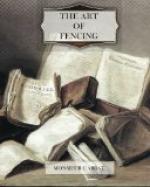As In all bodily Excercises, a good Air, Freedom, Vigour, and a just Disposition of the Body and Limbs are necessary, so are they more especially in Fencing, the least Disorder in this Case being of the worst Consequence; and the Guard being the Center whence all the Vigour should proceed, and which should communicate Strength and Agility to every Part of the Body, if there be the least Irregularity in any one Part, there cannot be that Agreeableness, Power of Defence, Justness, or Swiftness that is requisite.
In order to be well in Guard, it is absolutely necessary that the Feet, as the Foundation that conduces chiefly to communicate Freedom and Strength to the other Parts, be placed at such a Distance from each other, and in such a lineal Manner as may be advantageous: The Distance must be about two Foot from one Heel to the other; for if it were greater, the Adversary, tho’ of the same Stature, and with a Sword of equal Length, would be within Measure when you would not, which would be a very considerable Fault, Measure being one of the principal Parts of Fencing, and if the Feet were nearer together, you would want Strength, which is also a great Fault, because a feeble Situation cannot produce a vigorous Action.
The Line must be taken from the hindmost Part of the Right Heel to the Left Heel near the Ancle. The Point of the Right Foot must be opposite to the Adversary’s, turning out the Point of the Left Foot, and bending the Left Knee over the Point of the same Foot, keeping the Right Knee a little bent, that it may have a Freedom of Motion.
The Body must be upright, which gives it a better Air, greater Strength, and more Liberty to advance and retire, being supported almost equally by the two Feet. Some Masters teach to keep the Body back in Favour of Measure, which cannot be broke by the Body when ’tis already drawn back, tho’ it is often necessary, not only to avoid a Surprize, but also to deceive a Man of superior Swiftness who pushes a just Length: Therefore ’tis much better to have the Liberty of retiring to avoid the Thrusts of the Adversary, or of extricating yourself by advancing towards him and pushing (as I shall observe in its proper Place) than to keep the Body in one Situation at a Distance, which being fixed, cannot deceive a Person who knows any thing of Measure; moreover, such a Retention of the Body does not only hinder the breaking Measure with the Body, but also the Left Leg is so oppressed with its whole Weight, that it would find it difficult to retire upon Occasion.
The Elbows must be almost on a Line, and of an equal Height, that one Shoulder may not be higher than the other, and that they may be both turn’d alike; the Left Hand must be over against the Top of the Ear, the Hilt of the Sword a little above the Hip, turning towards Half Quart, the Thumb extended, pressing the Middle of the Eye of the Hilt, keeping the Fingers pretty close to the Handle, especially the little one, in order to feel the Sword firmer and freer in the Hand.




